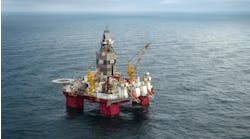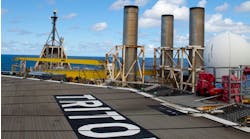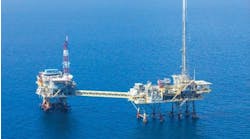There is a new frontier in Alaska and it is increasingly accessible to the independent. The new plays are a banquet for geologists who love stratigraphic traps; these reservoirs can be a more equal playing field, as well as large in extent. The hot concepts today are in Jurassic and Lower Cretaceous sands west of the Prudhoe Bay - Kuparuk complex, both onshore and offshore.
Each of these plays is geologically different, and as such, overlap each other in distinct and mappable trends. Dry holes are few on Alaska's North Slope, due to the large size of fields and increasing amount of control, both subsurface and seismic. With dramatic reductions in costs, expanding infrastructure, and considerable unleased wildcat acreage, both state and federal, the North Slope is no longer the exclusive domain of the major oil companies.
Typically, the large oil and gas provinces are first opened by the majors, often finding the largest structural traps, the more prominent geological and geophysical anomalies, followed by wider participation by independents and even individuals. And often, these later finds are significant - what geologist Michel T. Halbouty has termed "the obscure and subtle trap."
North Slope geology
An understanding of North Slope geology is critical to success. For 20 million years of Jurassic time, a passive and gradually regressive shoreline accommodated sediments from a low relief provenance immediately north-northwest (in relative terms). This resulted in at least three sequences of fine-grained, rather uniform sandstones with associated channels. These trends can be mapped over long depositional strike distances, generally trending ENE-WSW. These are the principal pay sands for the Alpine, Fiord, and Kuukpik Fields.
From the Thetis Island #1 well southwestward through the Kuukpik Unit and the Colville River Unit, a distance of some thirty miles, every well drilled but one has found oil in Jurassic sands. The single exception is the Gulf #1 Colville Delta, where the sands are absent on a structural high. Temptation #1, just outside the Colville River Unit, also tested oil in both Kuparuk and Nechelik sands. In earliest Cretaceous time, a local north source shed coarser sands termed Kuparuk "C." These sands are preserved locally above a major unconformity principally in paleo-low areas, and with generally high quality reservoirs.
There followed a period of rifting during which the Alaska North slope landmass separated from the Ellesmerian high to its relative north, colliding with the central Alaska craton, beginning the Brooks Range complex and the Colville Basin. Principal evidence of this is the highly radioactive zone (HRZ) shale, a rift-related deepwater event, and a hydrocarbon source.
Above HRZ lies the Lower Cretaceous turbidites, the initial deposits from the early Brooks Range uplift to the southwest and the developing basin in front of it. Prograding sediments from the emerging uplift spread out over the fronting plains and into the fringing ocean to the northeast. These sediment loads periodically flowed downslope, forming fans off the deeper shelf and settling into the base-of-slope as turbidites. These are prograding sequences, overlapping eastward with time. Some of these sediments can be good reservoirs, such as at Tarn Field. Most have oil shows, and many may represent bypassed producers, or strong leads for future exploration.
Recent production
The Alpine Field is the largest onshore discovery in the US in the past 10 years, at an estimated 429 million bbl recoverable. Development is underway. This will be the first field in history developed completely with horizontal wells, utilizing intervening horizontal miscible water-alternating-gas (MWAG) injection wells on a 1:1 ratio. - Alpine Field type log: ARCO #1 Bergschrund discovery well, showing the Alpine Sand relative to other possible pay sands.
Horizontals will average 3,000 ft. Wellbores will be 1,500 ft apart. Arco forecasts a 45% recovery of oil in place from this program.
The electric log of Bergschrund #1 is a type section for this area. The Alpine Sand at 6,838 ft flowed 2,380 b/d of 40° API gravity oil. Indications are that the Nechelik Sand at 7,308 ft may be also productive, as is the shelf margin Torok Sand above HRZ, in some wells in the field.
The Nuiqsut Sand at 7,050 ft is tight at this location, but is the pay in the Kuukpik Unit to the northeast. However, reservoir development in the Nuiqsut Sand has not to date been seen to be as good as Alpine Sand. First production from Alpine is forecast for August 2000 into a new pipeline connecting with Kuparuk Field to the east.
In July 1999, Arco announced flow tests at its Fiord #5 discovery well, in the Colville River Unit, just north of Alpine. The well flowed 2,500 b/d of oil from 75 ft of perforations in both Kuparuk and Jurassic sands, with oil gravity reported as 30° API. Oil with an API gravity of 32° was produced from 15 ft of Kuparuk, at 1,100 b/d of oil, and 1,400 b/d of oil from 60 ft of Jurassic after fracturing.
Arco preliminary estimates are for over 50 million bbl reserves at Fiord. It is interesting to note that the earliest well drilled in the Alpine-Fiord area was the Sohio #1 Nechelik, in 1982, between the present Fiord and Alpine Fields. The well was cored and found 65 ft of oil saturated Nechelik Sand and was not tested. This is probably the Fiord pay zone (logs of Fiord #5 are proprietary information).
In May 1999, a lease sale in NPRA brought total high bids of $104.6 million for 867,000 acres of leases, mostly in the immediate area west and southwest of Colville River Unit. The US Bureau of Land Management has approved permits to Arco for eight exploratory wells to Jurassic depth, in this area. The first three will be drilled immediately.
Other subtle traps
The Tarn Field, southwest of Kuparuk, is another in a growing list of subtle traps. Suppressed electric log character due to the finely interbedded shale/sand nature of shelf slope sands left this idea untested until the past decade. The type log, Bermuda #1, pre dates the field discovery and shows the stacked turbidite sand packages in the Tarn area. Arco states that all these sands are potentially productive, and three have been established so far: Bermuda, Cairn, and Arete. The discovery well was perforated in Bermuda, and flowed 1,900 b/d of 37° API gravity oil after fracturing.
Production at Tarn has exceeded expectations. As of November 1999, the field was on line for 16 months, and 19 wells have accumulated a production of 12.3 million bbl of oil, with daily production averaging 26,714 b/d of oil. Early pressure maintenance, both water flood and miscible, has flattened the decline curve. Apparently there is good communication between wells.
Arco has at least five wildcat prospects on a north-south trend with Tarn. These appear to lie along this turbidite depositional trend. Their Meltwater N. #1 is now drilling seven miles south of Tarn Field.
Another turbidite trend will soon be explored at locations south of Alpine near Arco #1 Nanuk, which found several well-developed sands at approximately the Tarn interval, though older. The gross thickness of sands at Nanuk is over 200 ft. Arco has announced two offsets to this well immediately. As at Tarn, this trend should lie at essentially a north-south base-of-slope direction. Company testimony indicates these sands are potential over a large area. Oil at Nanuk is reported as 40° API gravity.
There are additional uphole producing sands, often having oil and gas shows, which are possible stratigraphic traps. They are mostly untested. These include the Nanushuk Fm. at 4,000 ft and the Tabasco Sands at 2,500 ft. To date, little attention has been paid to these.
Kuukpik and Fiord Field areas lie both onshore and offshore in the shallow Beaufort Sea. Many offshore locations can be accessed from a land-based pad directionally drilled to desired bottom hole locations. Those locations, too far from land access, can be drilled from existing offshore islands (Thetis Island #1) or from manmade islands built up from the seafloor.
The North Slope's first subsea pipeline is under construction now from a production island at Northstar Field, north of Prudhoe Bay.
References
- Halbouty, M.T., The Deliberate Search for the Subtle Trap, AAPG Memoir 32, 1982, 351 pp.
- Kornbrath, R.W. et al, Petroleum Potential of the Eastern National Petroleum Reserve-Alaska, State of Alaska, Department of Natural Resources, Division of Oil & Gas, April 1997, 30 pp.
- Moore, T.E. et al, Stratigraphy, Structure, and Geological Synthesis of Northern Alaska, USGS open file report 92-330, 183 pp.
- Kuparuk River Unit - Testimony for Tarn Oil Pool Rules, State of Alaska Oil & Gas Conservation Commission, ARCO-operator, April 28, 1998.
- Alpine Oil Pool Rules Hearing, State of Alaska Oil & Gas Conservation Commission, ARCO-operator, December 3, 1998.
Conventional leasing procedures
Participation in North Slope plays is not very different from other areas of state and federal minerals. All lease sales are scheduled and by sealed bids. State of Alaska minerals lie east of the Colville River in the area of this discussion, and the first three miles offshore. Federal minerals lie west of the Colville River (NPR-A) and beyond three miles offshore. The State of Alaska limits a lessee to 500,000 acres of leases offshore, and 500,000 acres onshore, excepting productive and unitized leases. This will limit leasing for some major companies. To date, virtually all production is from state leases. Small independents and individuals own over 240,000 acres of state leases, or some seven percent of the total.
The author has been bidding on State of Alaska oil and gas leases for 10 years and has won a few from the majors in places they didn't care about at the time. The subtle strat traps have contained many surprises, improving values of leases in some areas formerly not popular.
One 1,186 acre lease was recently sold to Alaska Venture Capital Group (AVCG, LLC). This lease was won in 1997 for $32.22/acre, outbidding Arco in a sealed bid sale two years before the discovery. This lease is two miles west of Arco's #5 Fiord discovery, and may represent a chance of production. A 3D seismic program in the area will guide development.


